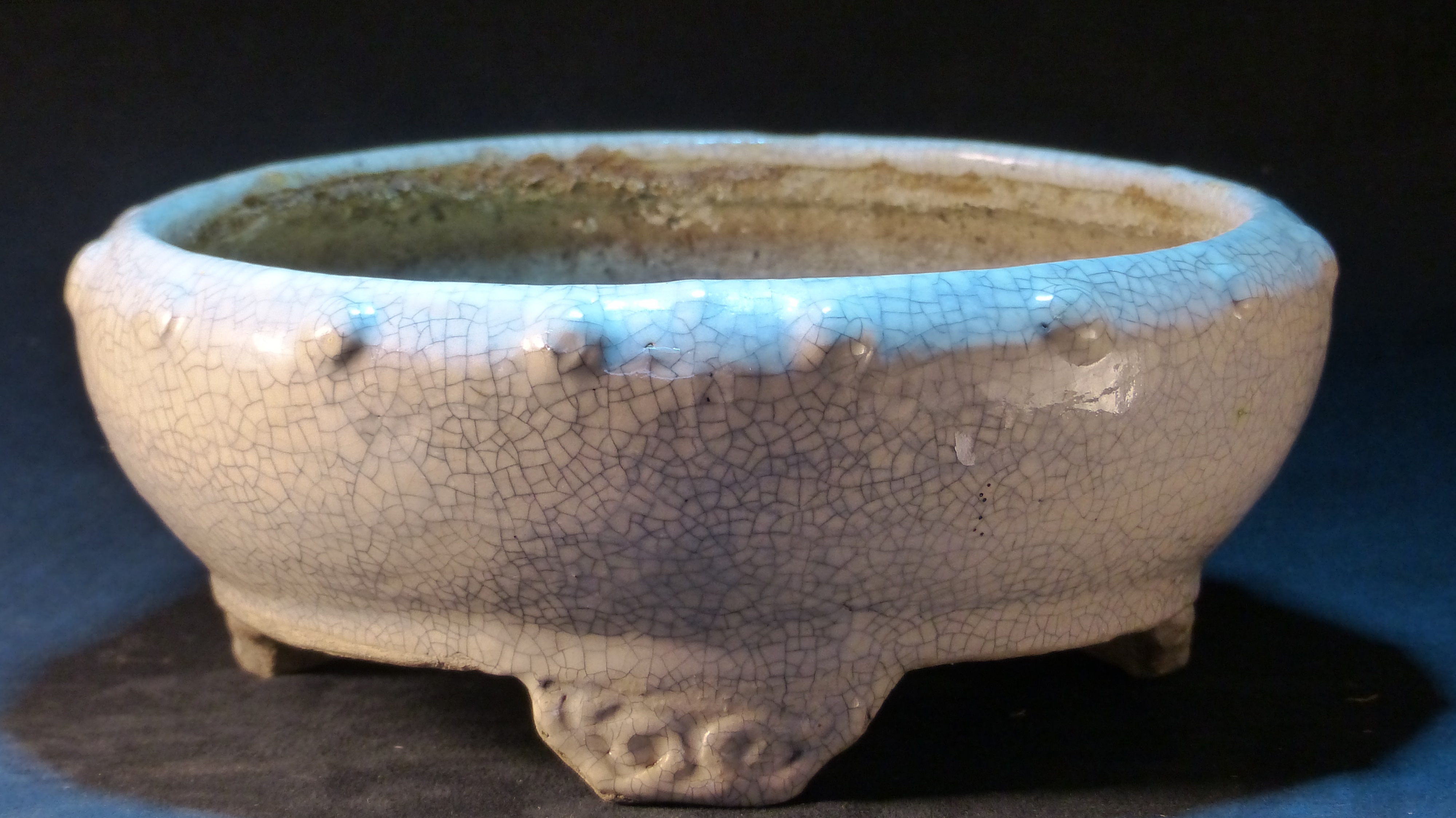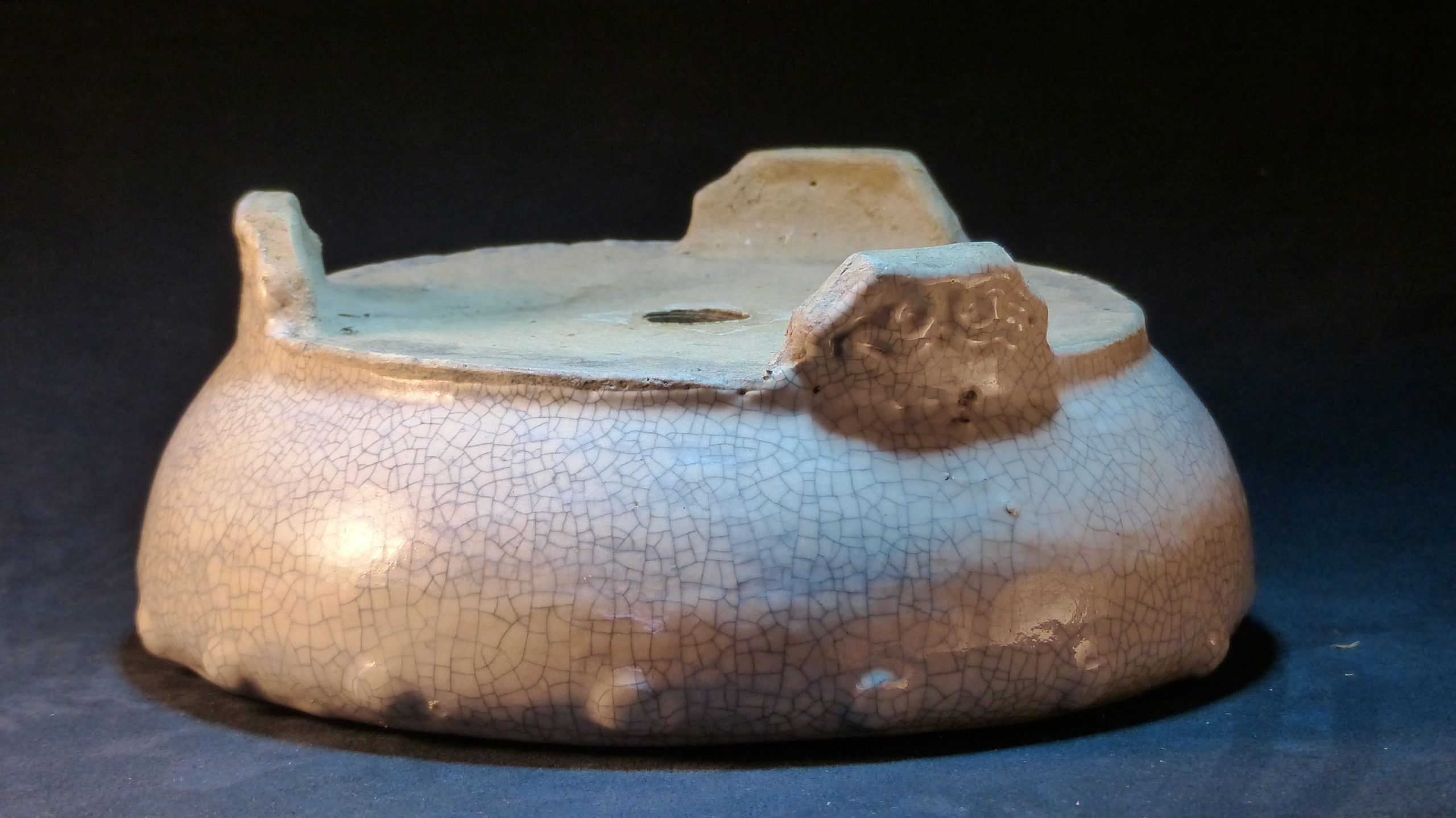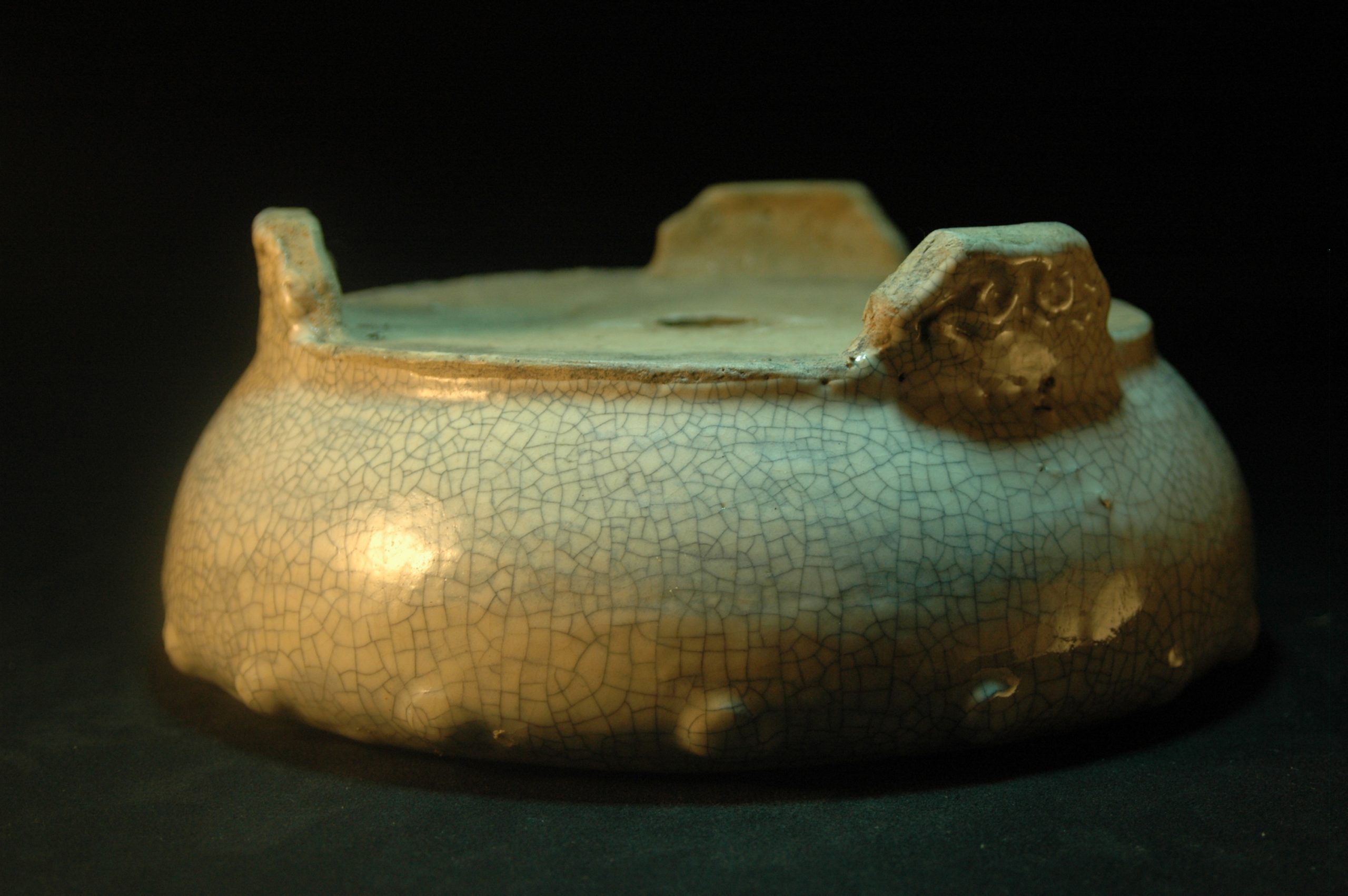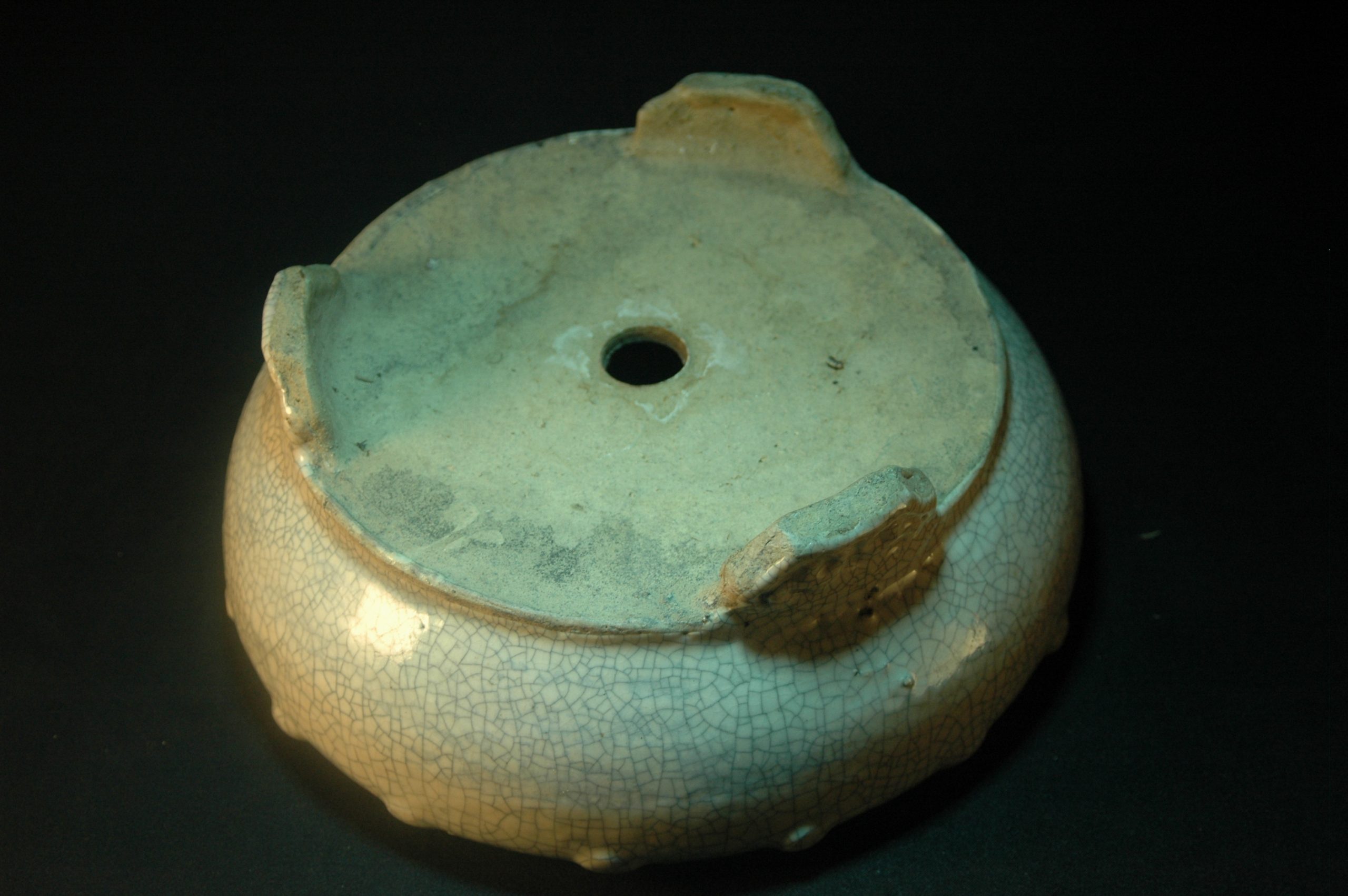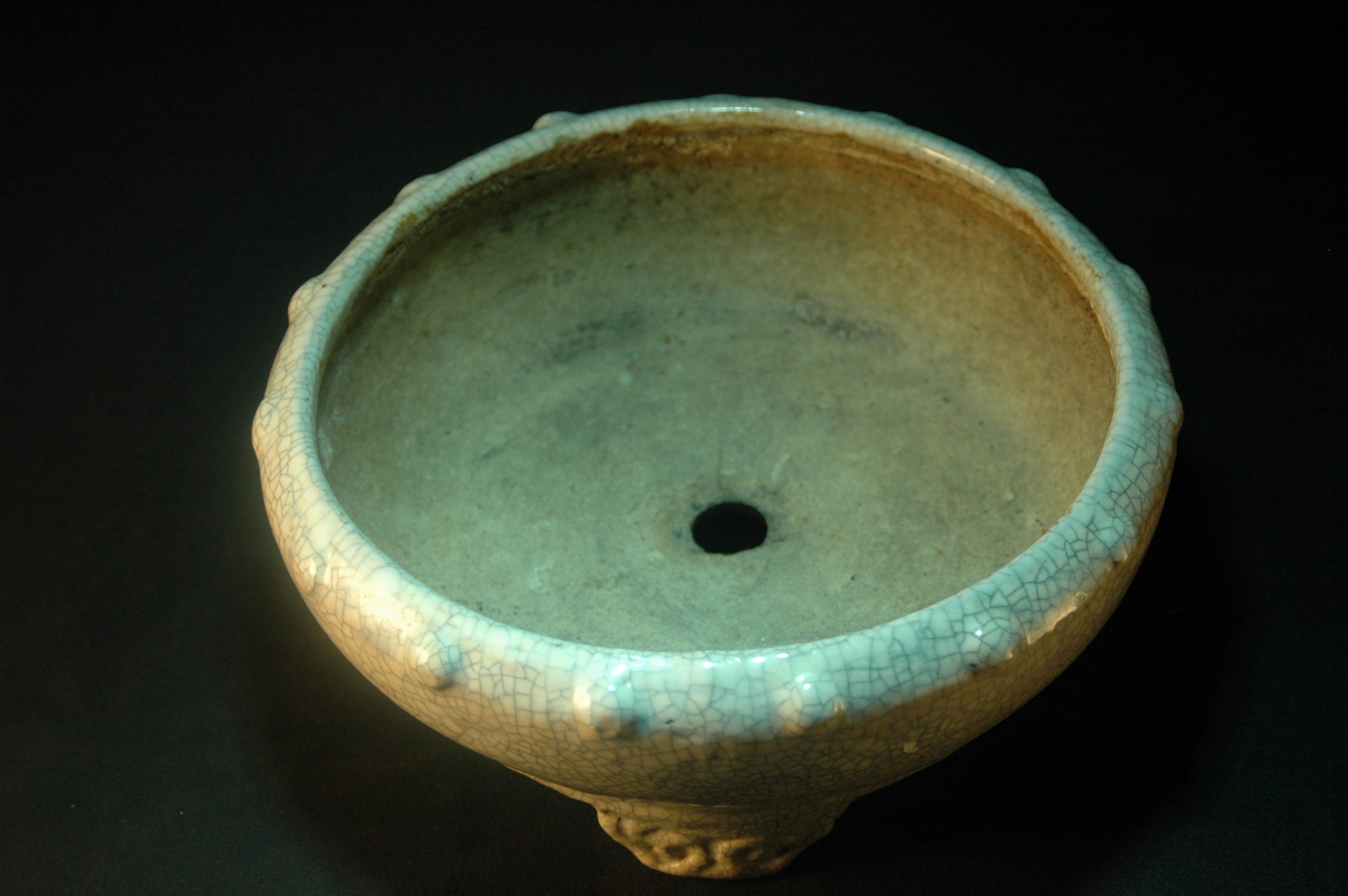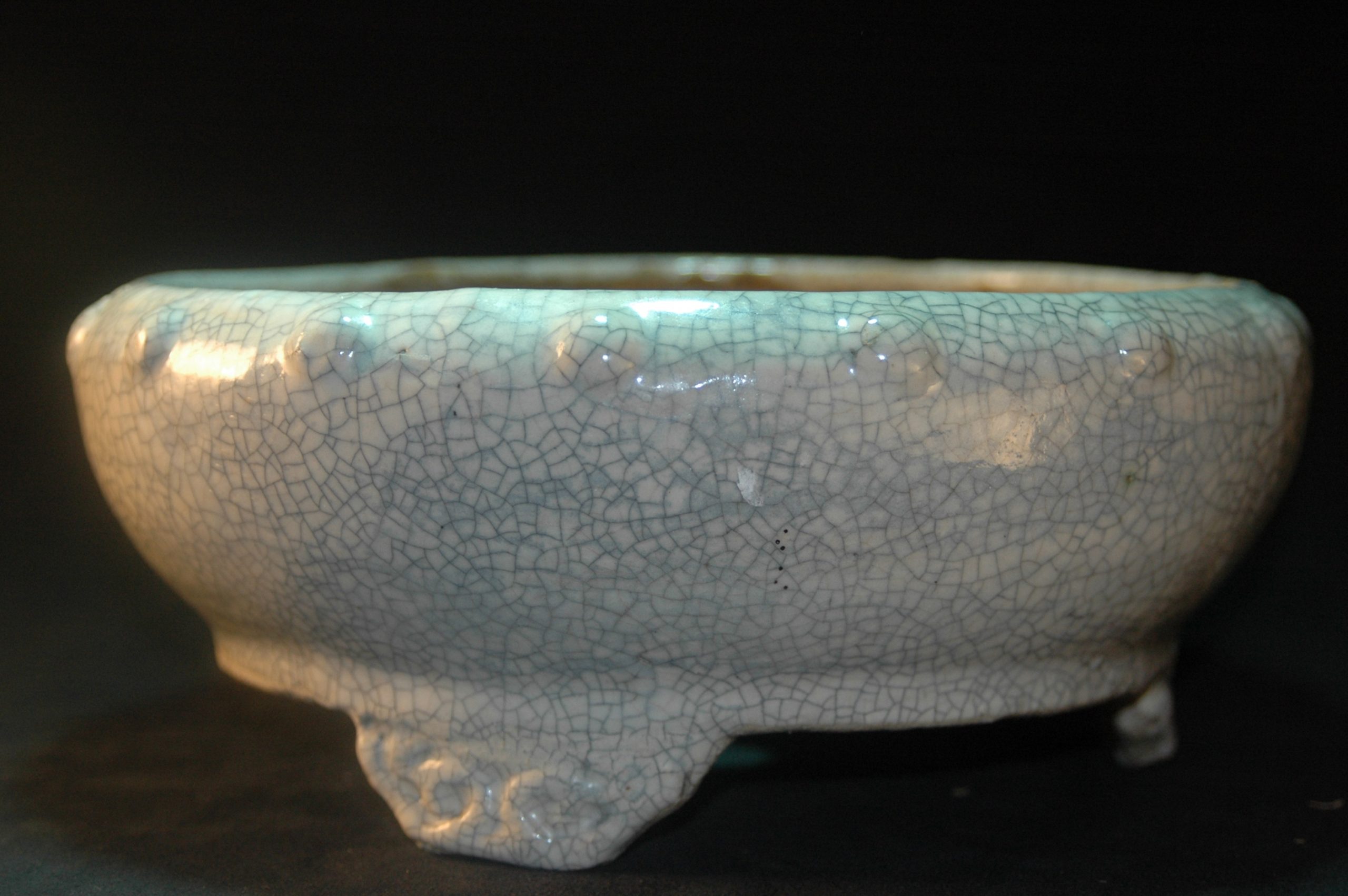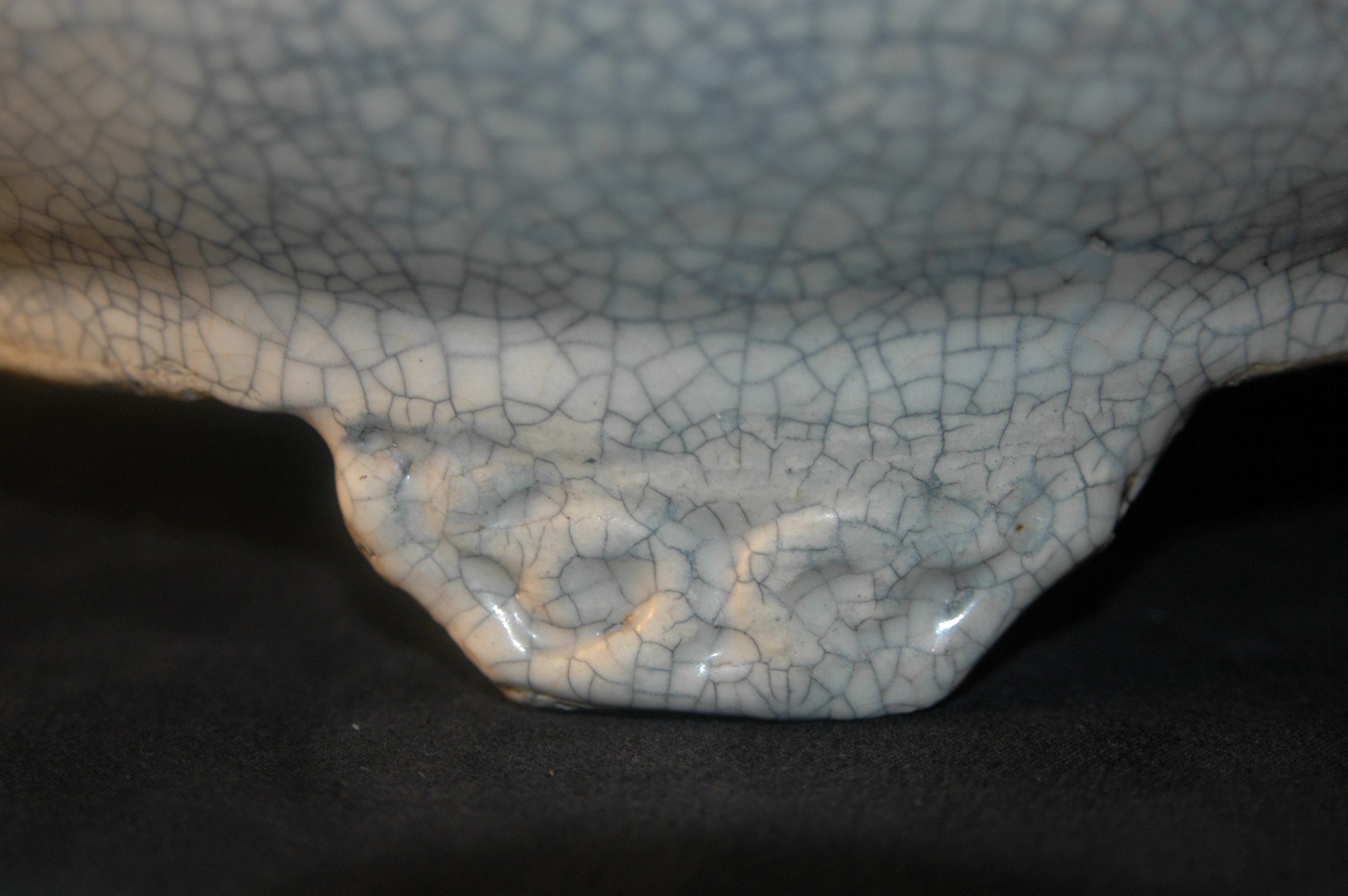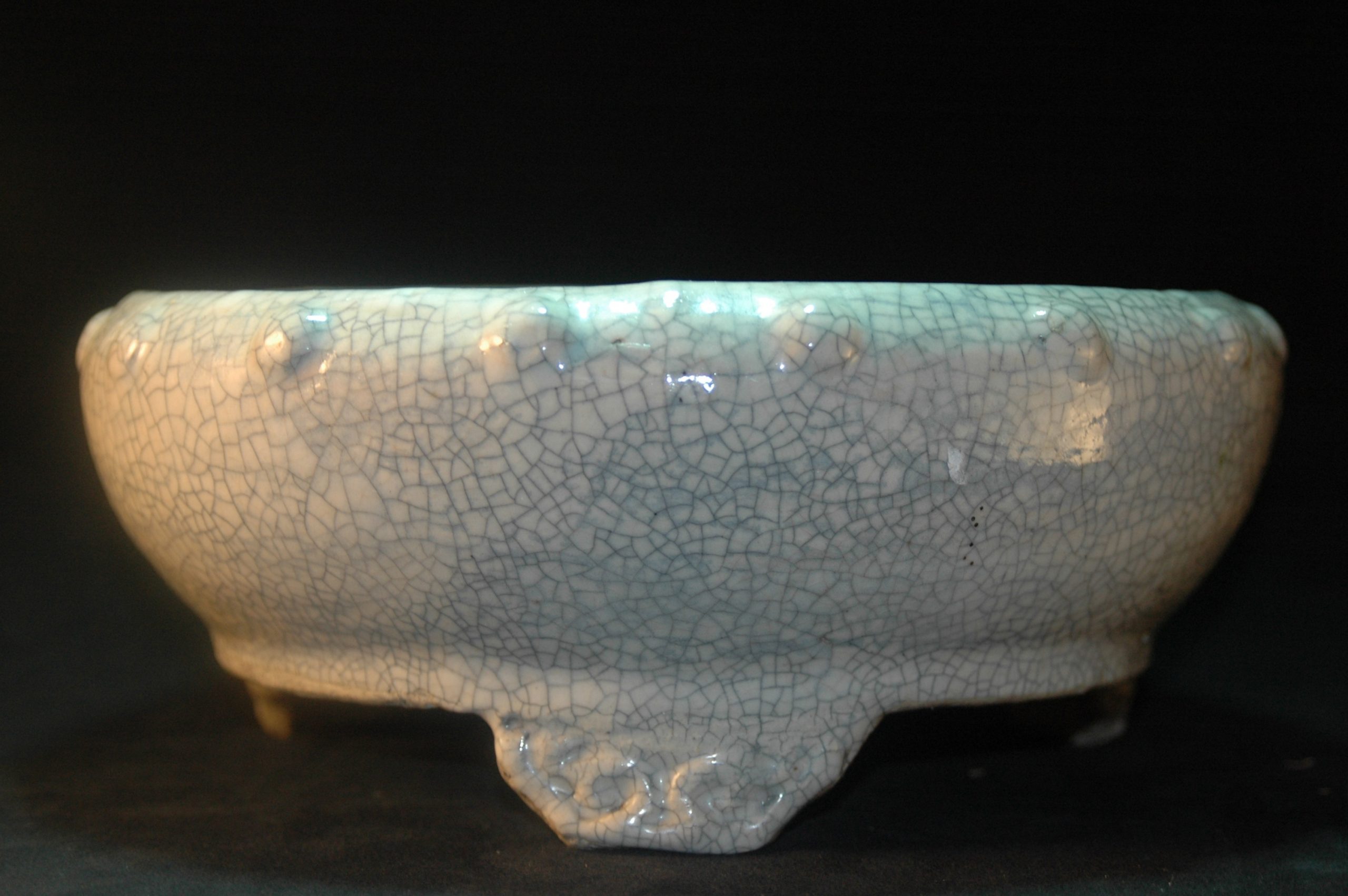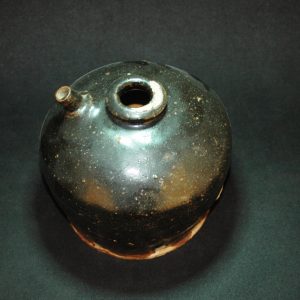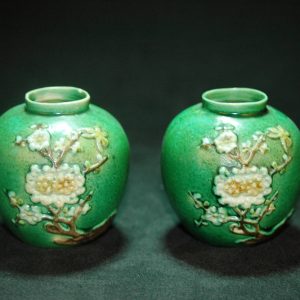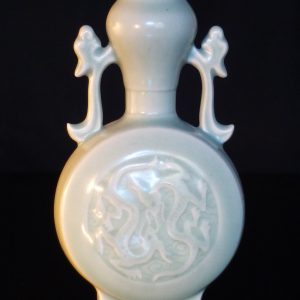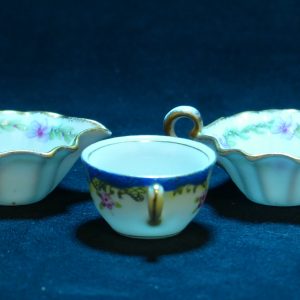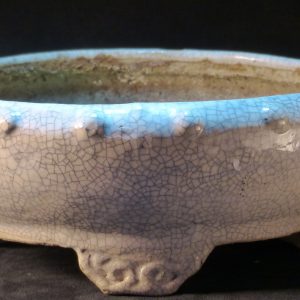Description
哥窑乳钉如意三足花盆(对)
参考:苏富比 北京东正拍卖有限公司
2011秋季艺术品拍卖会
文房清玩专场
LOT号: 0419 清雍正 红釉鼓钉纹三足洗 收藏
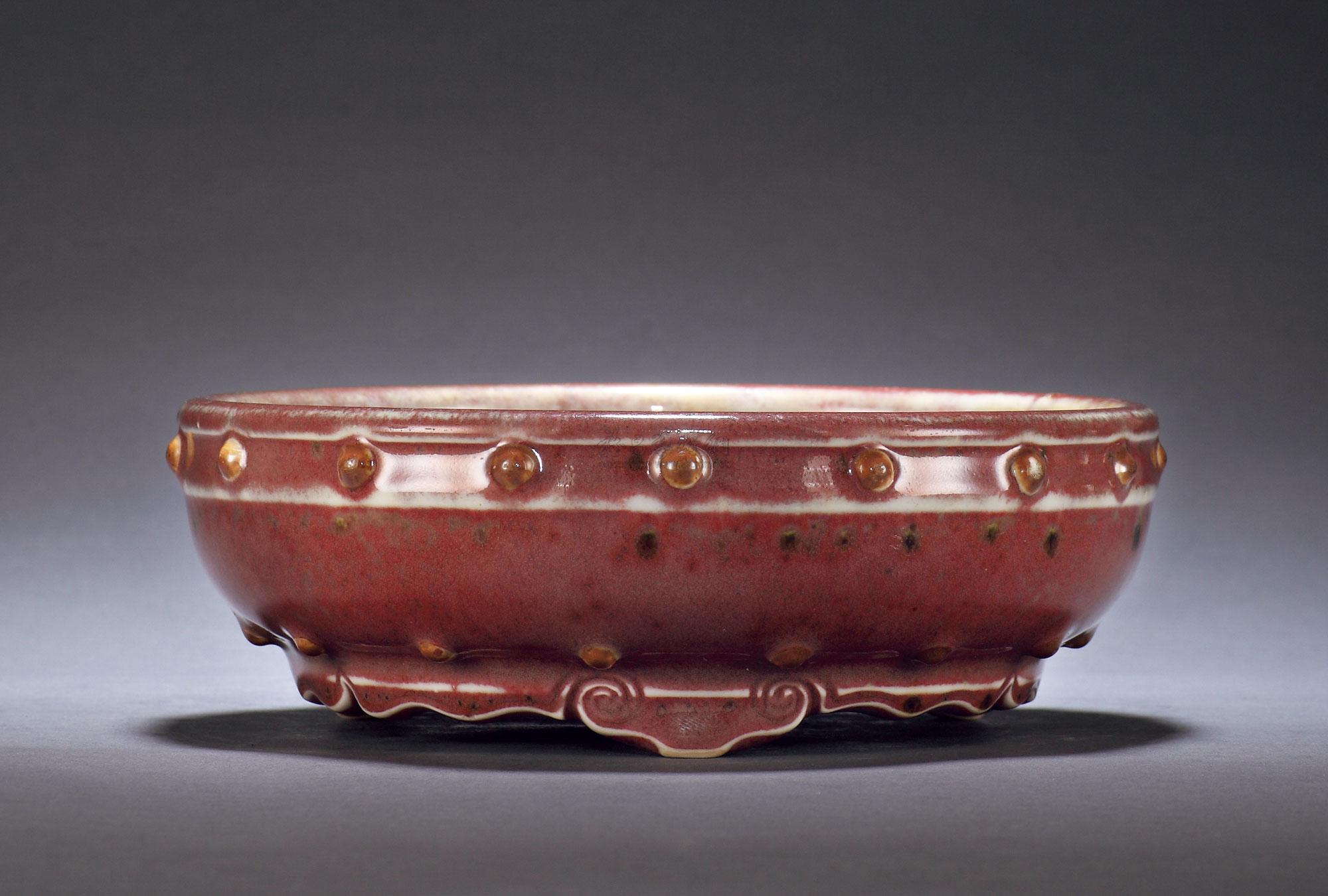
拍品信息
作者 —
尺寸 直径18.1cm
作品分类 工艺品杂项>笔墨纸砚
创作年代 清雍正
估价 RMB 120,000-150,000
成交价 RMB 184,000HKD 225,490USD 27,600EUR 20,240
专场 文房清玩专场
拍卖时间 2011-11-17
拍卖公司 北京东正拍卖有限公司已开通官网
拍卖会 2011秋季艺术品拍卖会
说明
直沿圆口,沿下饰乳钉,下承三如意云头足。里外满施仿钧釉,无青、钧红融汇交错,古雅悦目。此器造型、釉色皆仿宋钧原制,形体端庄古朴,釉层晶莹肥厚,釉面色泽雅致,为雍正一朝尚古之风的杰制。雍正皇帝十分喜爱钧窑,相关文献亦记录了当时景德镇仿古的状况。此洗代表了雍正时期仿钧所达到的较高水平。
参考:苏富比 596
中國藝術品
心懩堂收藏
元至明 龍泉青釉鼓釘三足小盆
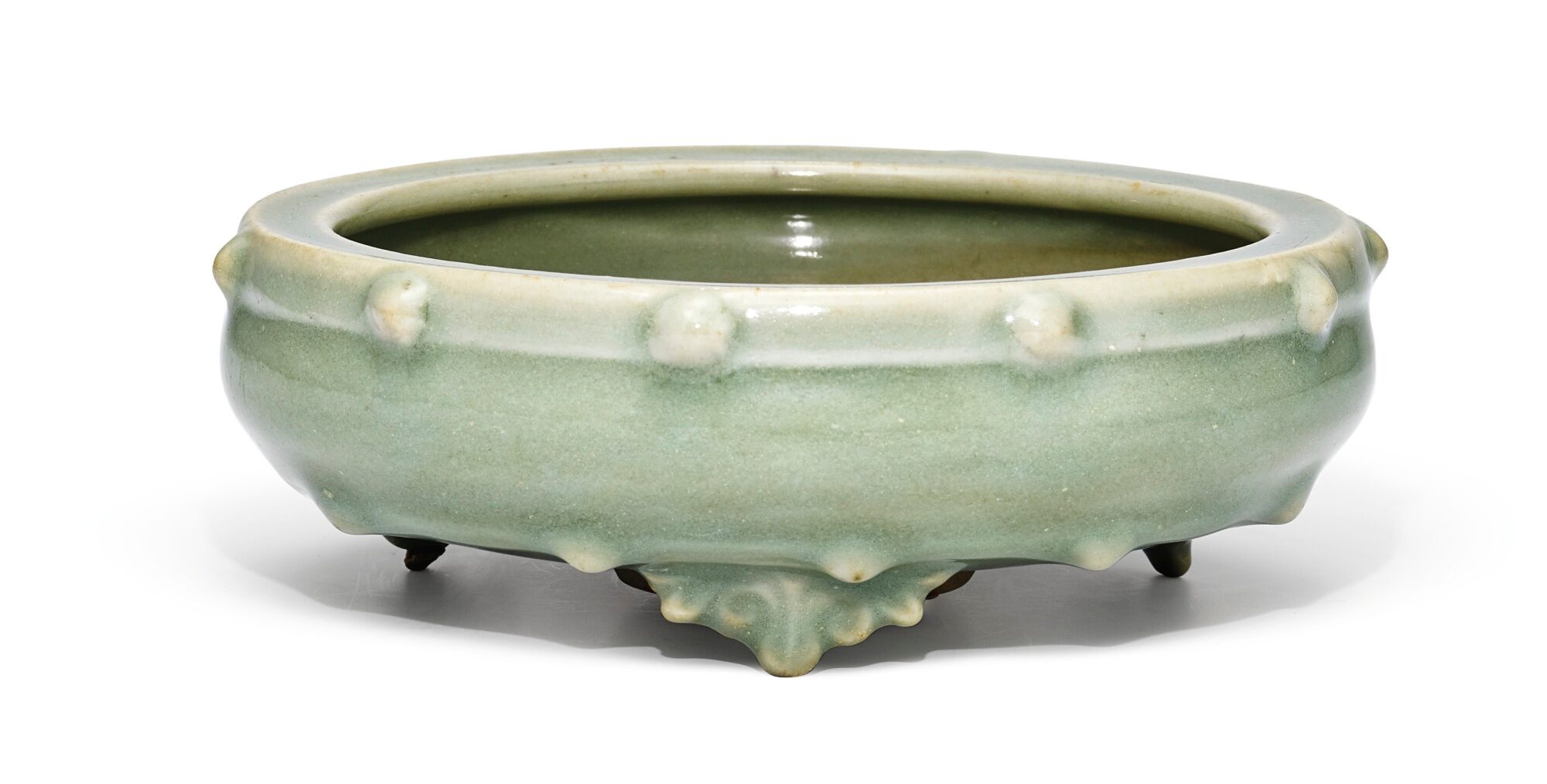
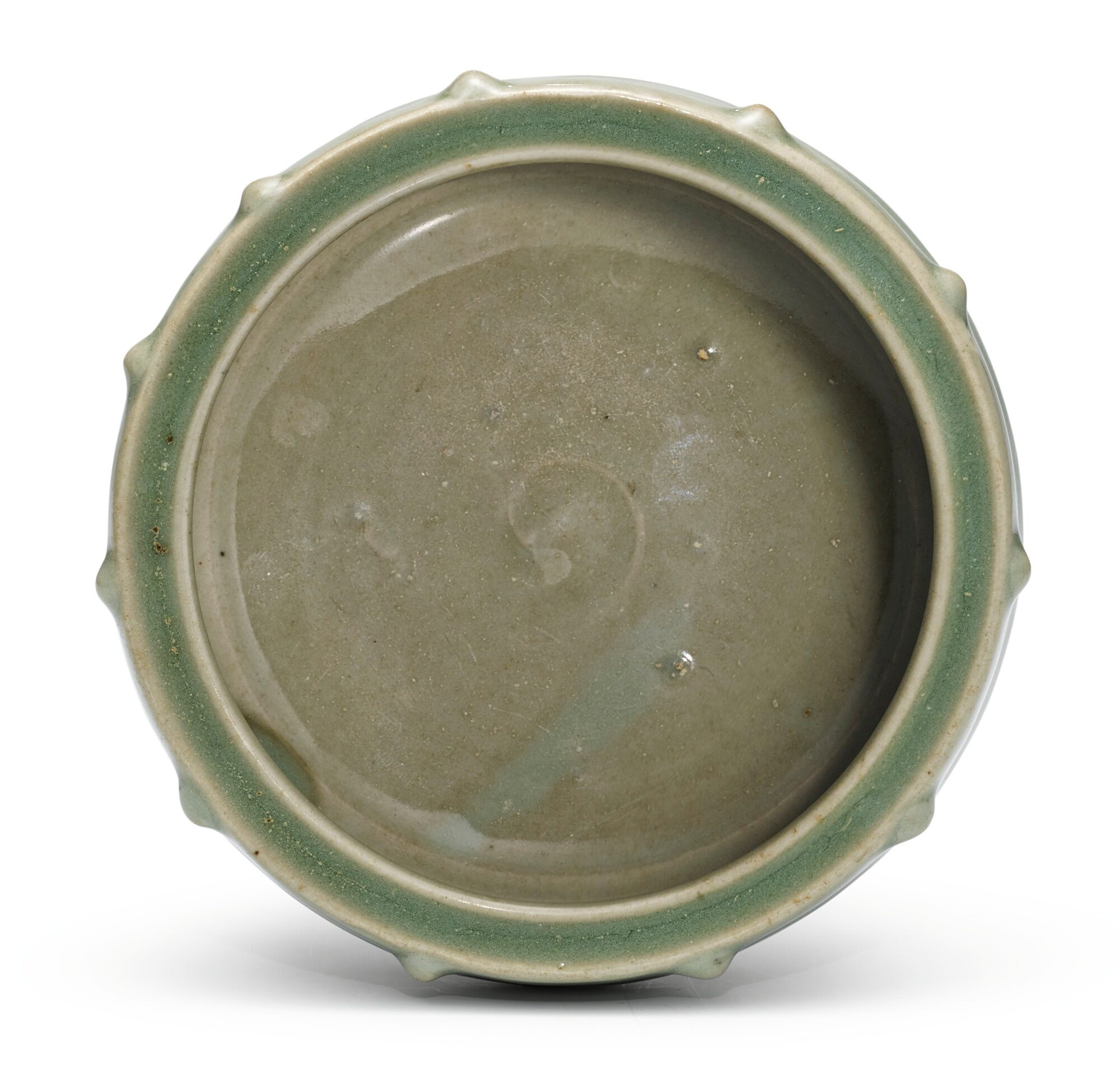
60,000 — 80,000港幣
拍品已售 106,250 港幣 成交價 (含買家佣金)
拍品詳情
元至明 龍泉青釉鼓釘三足小盆
13.5 公分, 5 1/4 英寸
來源
香港大成古玩有限公司,1990年代
參考:紐約大都會博物館 元 紫钧釉 乳钉水仙盆 Bulb Bowl
China
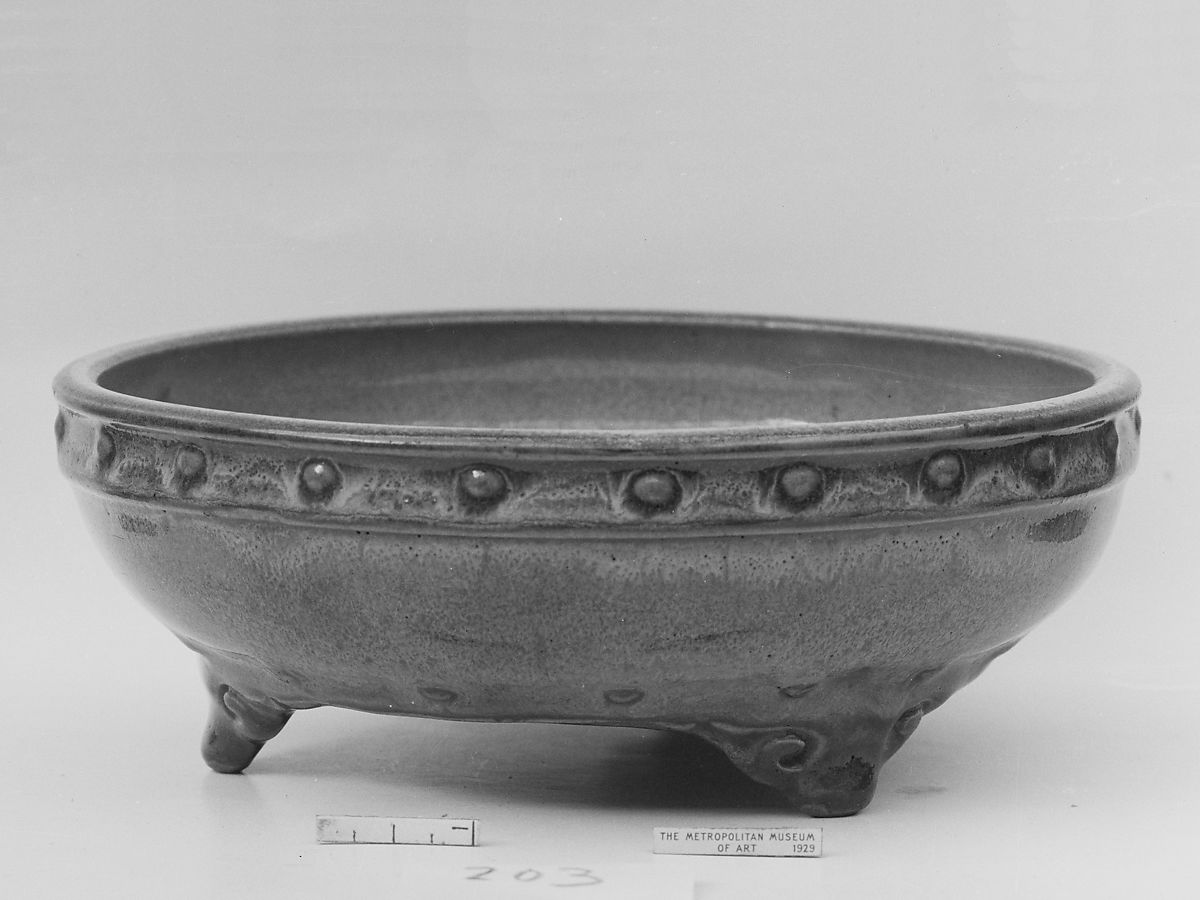
Object Details
Period:Yuan dynasty (1271–1368)
Culture:China
Medium:Stoneware with purple-blue glaze (numbered Jun ware)
Dimensions:H. 2 3/4 in. (7 cm); Diam. 7 3/8 in. (18.7 cm)
Classification:Ceramics
Credit Line:H. O. Havemeyer Collection, Bequest of Mrs. H. O. Havemeyer, 1929
Accession Number:29.100.203
Signatures, Inscriptions, and Markings
Marking: Qi (7)
Provenance
Mrs. H. O. (Louisine W.) Havemeyer , New York (until d. 1929; bequeathed to MMA)
Exhibition History
New York. The Metropolitan Museum of Art. “The Douglas Dillon Legacy: Chinese Painting for the Metropolitan Museum,” March 12, 2004–August 8, 2004.
New York. The Metropolitan Museum of Art. “Chinese Painting, Masterpieces from the Permanent Collection,” August 28, 2004–February 20, 2005.
New York. The Metropolitan Museum of Art. “Art of the Brush: Chinese Painting and Calligraphy,” March 12, 2005–August 14, 2005.
New York. The Metropolitan Museum of Art. “Secular and Sacred: Scholars, Deities, and Immortals in Chinese Art,” September 10, 2005–January 8, 2006.
New York. The Metropolitan Museum of Art. “The Four Seasons,” January 28, 2006–August 13, 2006.
New York. The Metropolitan Museum of Art. “Journeys: Mapping the Earth and Mind in Chinese Art,” February 10, 2007–August 26, 2007.
New York. The Metropolitan Museum of Art. “Landscapes Clear and Radiant: The Art of Wang Hui (1632–1717),” September 9, 2008–January 4, 2009.
Timeline of Art History
Timelines
Central and North Asia, 1000-1400 A.D.
China, 1000-1400 A.D.
参考:六合和熙-重要私人珍藏
105 南宋至元 官窰海棠式花盆
估價 15,000,000 — 20,000,000 港幣
拍品已售 38,514,000 港幣 成交價 (含買家佣金)
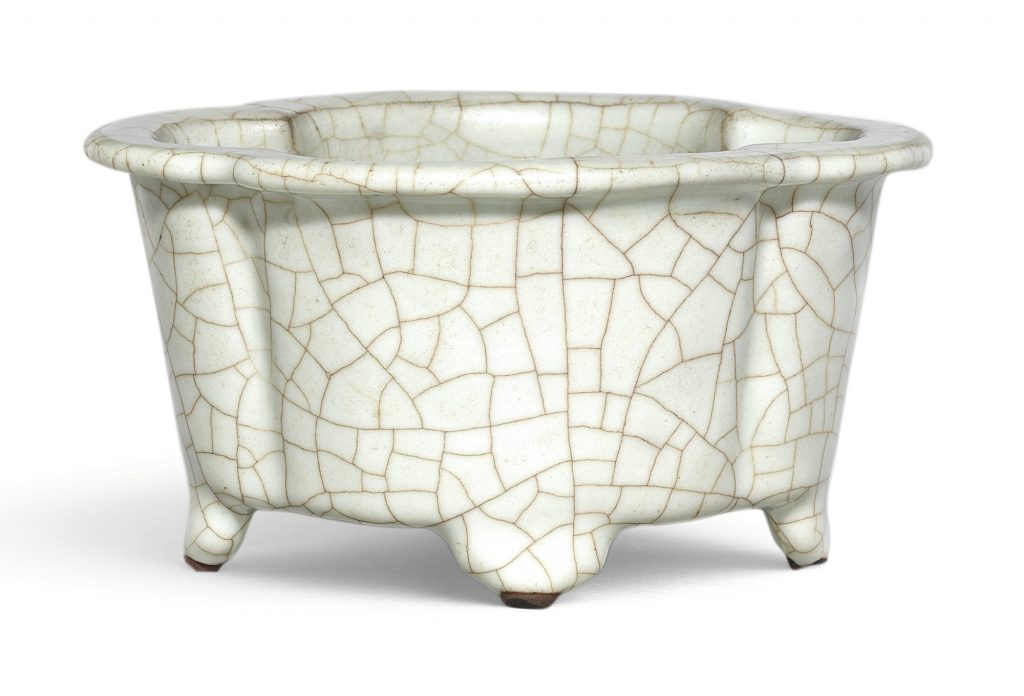
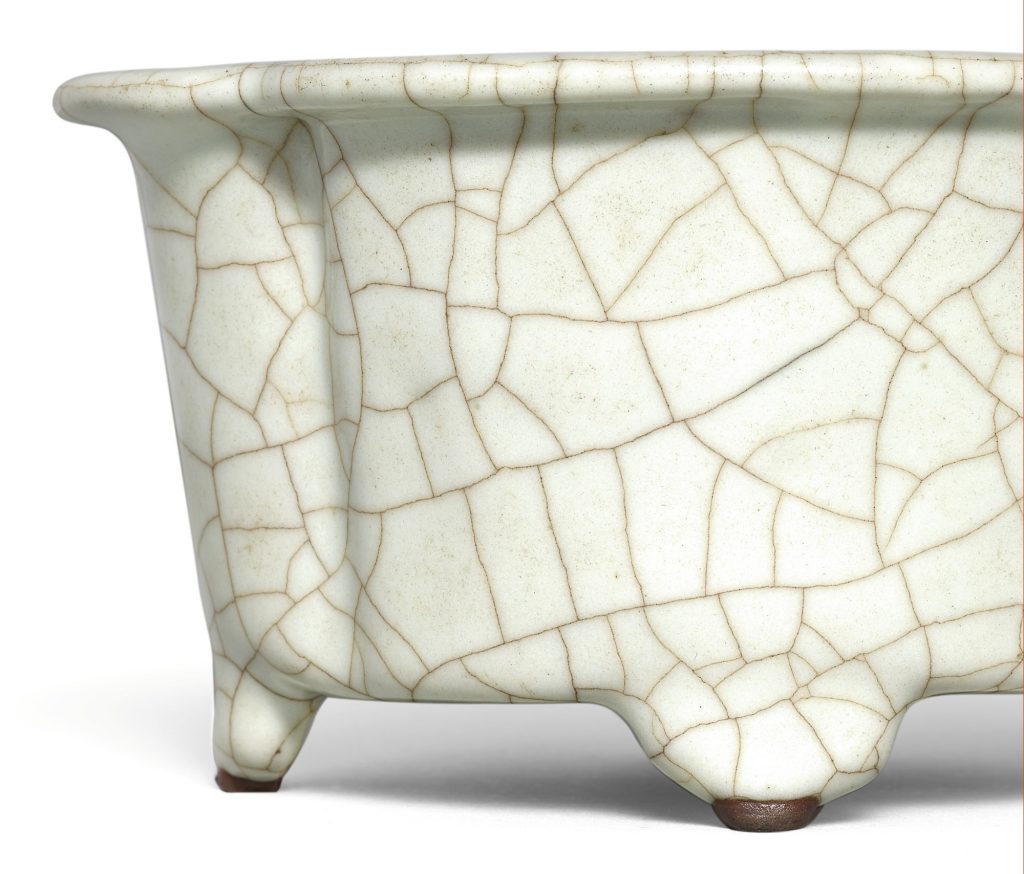
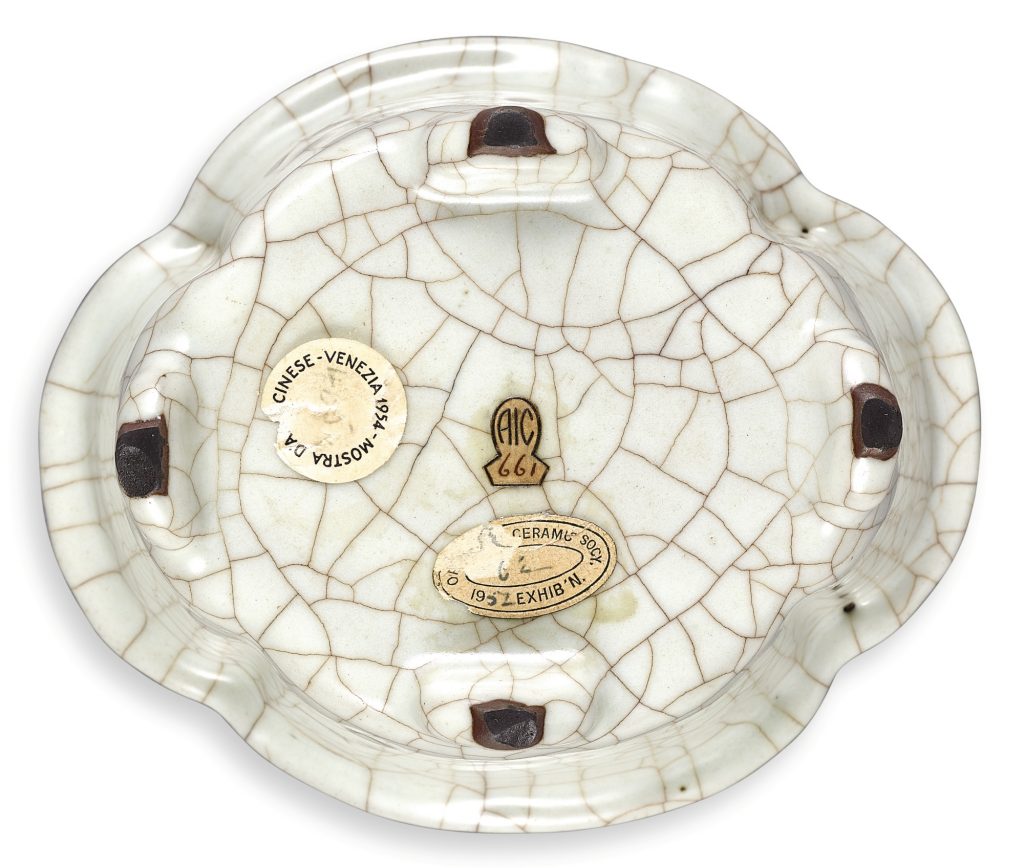
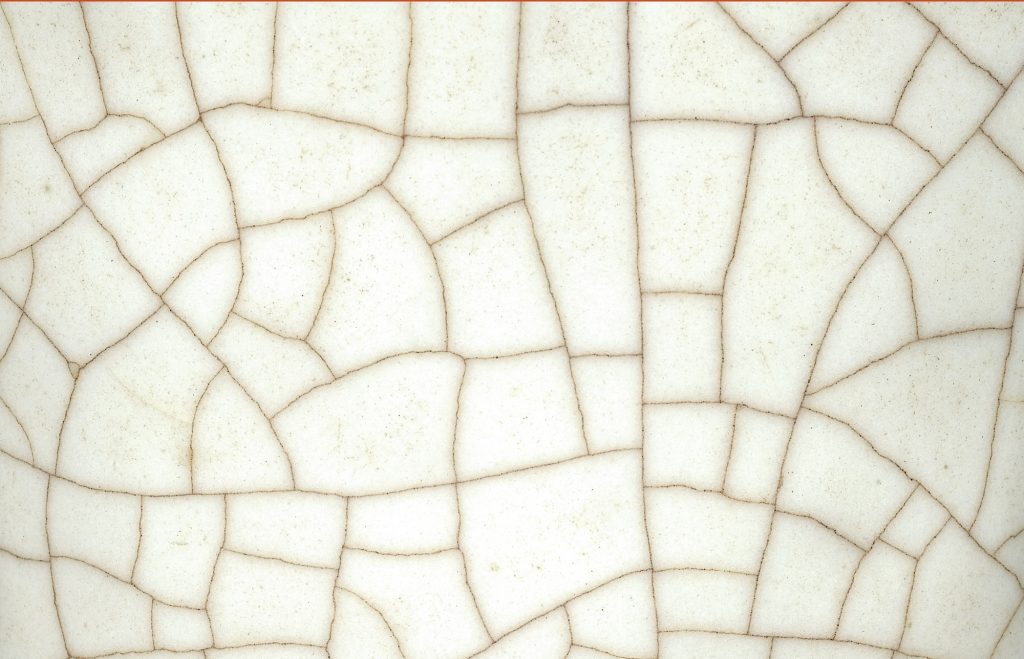
南宋至元 官窰海棠式花盆
15 公分,5 7/8 英寸
來源
艾弗瑞.克拉克夫人(1890-1976年)收藏,編號661
Dr Lin 收藏,售於倫敦蘇富比1975年3月25日,編號102
2003年購自坂本五郎(1923-2016年)
展覽
《Exhibition of Chinese Art for Chinese Medical Relief》,倫敦,1938年(標籤)
《The Oriental Ceramic Society Exhibition of Ju and Kuan Wares: Imperial Wares of the Sung Dynasty, Related Wares and Derivatives of Later Date》,倫敦,1952年,編號62
《Mostra d’Arte Cinese》,多奇宮,威尼斯,1954年,編號465
出版
大維德爵士,《Chinese Connoisseurship: The Ko Ku Yao Lun. The Essential Criteria of Antiquities》,紐約,1971年,圖版22d
相關資料
寥若晨星
官窰海棠式盆
薛好佩博士
此官窰海棠式盆素淨端麗,其釉色青灰,瑩澈溫潤,片紋層疊,疏密有致,製於南宋至元朝年間(十二至十三世紀),為中華瓷海之明珠,熠熠生輝,甚為後世所珍。本品釉厚若堆脂,觸之凝滑如絲,觀之賞心悅目。將其置於放大鏡下,可見釉層滿佈氣泡,細入毫芒,古稱「聚沬攢珠」。氣泡經散射而晶亮通透,使器表隱現酥光寶暈,宛若和田美玉。釉上又以開裂綴襯,素有「金絲鐵線」之述。此般開片雖因窰溫差異自然形成,然瓷匠為求佳器,於施釉、柴燒工序間之往復探求及摸索,自不必多言。官窰胎土色深,於底足及器心支釘痕露胚處可窺一二,蓋因富鐵元素所致。故而,清時景德鎮窰工仿官,先於白胎上罩醬色化妝土,而後施釉,以擬「紫口鐵足」之視效。本器採四瓣花口,雅雋倩秀,恰似垂絲海棠悄然盛開,故以「海棠」命名。海棠葳蕤,白中透粉,甚適於心,又「堂」指家室,與「棠」同音,故海棠被賦予「富貴滿堂」之吉祥寓意而多應用於器,本例便如是。取形海棠,或另暗示其為院庭花器;宋人風雅,時興置盆景(日本稱盆栽)於案之藝事,此器盈盈可握,嬌小玲瓏,亦或正是製作盆景之嘉材。有關盆景及其歷史之詳盡論述,可參考本場拍品編號104。
官釉佳瓷窰火天成,雖世間難覓全然相同之器,然與本品造型相仿者有二,其一現存北京故宮博物院,稱為「修內司窰海棠式花盆」,圖刊於李炳輝編,《宋代官窰瓷器》,北京,2013年,圖版53(圖一);其二貯台北故宮博物院,收入該院展覽《貴似晨星—清宮傳世十二至十四世紀青瓷特展》,台北,2016年,編號IV-11(圖二),據院內學者研究,其乃南宋至元製品,模印成形,支釘墊燒。江西省樟樹市劉公廟鎮南宋開禧元年墓(1205年)出土一相類官釉海棠式盆(圖三),據其可推,前述三例之燒成年代可上溯至十三世紀初。此書同錄一青釉海棠式花盆(編號IV-12),體量稍大,口沿嵌銅扣,底承四足。台北故宮專家比較本院館藏元代鈞窰器,發現相同器型之海棠式盆亦在元鈞之列,故為其斷代提供依據(下文詳述)。
南宋官窰歷來彌足珍罕,乾隆帝曾賦詩嘆慨,憾之存世甚微,還著人將其所作詩文刻於清宮典藏之官窰器底部,此器保留至今,現存倫敦大英博物館。全詩如下:
官窰名始宋南渡,後苑製效政和故;成章提擧惟御用,臣庶弗敢過而顧。
即今六百有餘載,晨星一二猶或遇;鬻從市廟供人玩,誰誠當年法令固。
不啻斯矣堪慨歎,即是殷周相鑒處。
乾隆丁酉春御題。1
高宗在詩中把後苑用瓷歸入修內司窰瓷之列。修內司為南宋官署名,執掌宮殿修繕事宜,其於京都臨安(今浙江杭州)按舊制開設窰場,專燒御品以供宮廷,史稱修內司窰,位於現今老虎洞窰址。靖康二年(1127年)金人揮兵南下,攻陷汴梁,宋室倉皇南渡,建新都於臨安。南宋百廢待興,故承北宋御窰舊制,燒造「新」官以為用。南宋文人葉寘《坦齋筆衡》詳錄之本朝官窰創燒始末,或為最早之相關論述:
京師自置窰燒造,名曰官窰。中興渡江,有邵成章提舉後苑,號邵局,襲故京遺制,置窰於修內司,造青器名內窰,澄泥為範,極其精緻,釉色瑩徹,為世所珍。後郊壇下別立新窰,比舊窰大不侔矣。2
葉氏有關修內司官窰之論述,多為後世因襲,乾隆皇帝之御題,亦參其所言也未可知。邵成章乃宋高宗時內侍省掌事太監,主持修內司窰務,督造御瓷,專供宮廷。此外,「澄泥為範,極其精緻,釉色澄徹,為世所珍」十六字乃讚官窰質美之經典,可曉其為仿北宋官汝而生,卻仍秀逸絕世,甚得上心。除卻修內司窰,葉氏所載郊壇下窰,亦於臨安城內,所出與修內司窰相若,然質稍遜。近期考古資料證實,南宋臨安城內確存官窰遺址二處,分別為皇城南側之烏龜山,以及皇城北牆內之老虎洞(前文已述)。依其窰址分佈及所產瓷片質量,可斷前者當為郊壇下窰舊址,而後者側屬修內司。
河南禹州鈞窰(也稱鈞台窰)多燒海棠式盆,與本品器形相似,享負盛名。這類器底刻有數字之鈞瓷花盆,釉質及發色與宋鈞相類,然造型精絕獨到,多為花口,美艷俊秀,加上數字款識,尤為特別。北京故宮藏「七」字款及「四」字款鈞釉海棠式花盆,可資比較,圖見《鈞窰雅集-故宮博物院珍藏及出土鈞窰瓷器薈萃》,北京,2013年,圖版63、64。大維德爵士於1952年東方陶瓷學會展覽介紹中,提及此官窰花盆時,指相較而言,鈞窰海棠式花盆及配套盆奩之存世量頗豐,弗利爾美術館所藏鈞瓷便為當中佳例。
此件官窰花盆來源顯赫,不但屬皇家御用之器,並經艾弗瑞.克拉克夫人及坂本五郎二位名家遞藏,非同凡品。艾弗瑞.克拉克為英籍美國人,乃當時唱片及影視業先驅,身居HMV及百代唱片公司要職。夫婦二人致力蒐集中國藝術瑰寶,均是東方陶瓷學會成員,並於1934-48年間擔任學會顧問,乃二十世紀初西方收藏界之翹楚。克拉克夫婦為協籌展覽,多次慷慨借出所藏珍品,如倫敦皇家藝術學院1935-36年中國藝術品展,及1952年東方陶瓷學會中國瓷器展。經大維德爵士夫人回憶,克拉克伉儷賞瓷「品味高遠、精湛」,其以陶瓷點裝居室,終日與藝為陪,於小閣樓擺放宋瓷,情趣純雅,不落俗套。日本收藏家、鑑賞家及著名骨蕫商坂本五郎先生,也是世界中國藝術品收藏之傳奇。先生藝涯橫跨近七十載,廣知博見,使其獨具慧眼,明辨善鑑,聞說能與物相通,可望其氣息,堪為業界權威,享譽國際。
1 見大英博物館網站:https://www.britishmuseum.org/research/collection_online/collection_object_details.aspx?objectId=3180074&partId=1&people=162439&sortBy=imageName&page=1 (登錄日期:2019年3月2日)。
2 《輟耕錄通鑑》,北京,1950年。
3 見中國社會科學院考古所編,《南宋官窰》,北京,1996年;杜正賢編,《杭州老虎洞窰址瓷器精選》,北京,2002年;以及張振常編,《南宋官窰文集》,北京,2004年。
4 大維德爵士,〈序〉,見《The Oriental Ceramic Society Exhibition of Ju and Kuan Wares: Imperial Wares of the Sung Dynasty, Related Wares and Derivatives of Later Date》,倫敦,1952年,頁4。
5 畢宗陶,《Collectors, Collections and Museums: The Field of Chinese Ceramics in Britain, 1560-1960》,牛津及紐約,2007年,頁171-2。
6 Jeffey Hantover,〈坂本五郎與「目利」之藝〉,《藝海觀濤:坂本五郎珍藏藝術.陶瓷》,2015年3月,頁12。
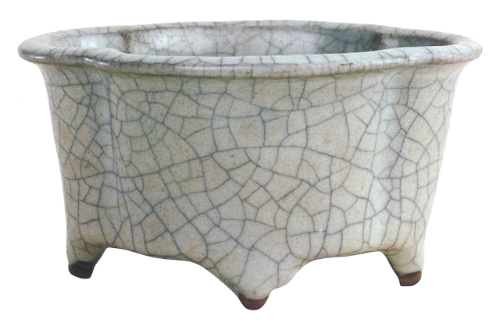
南宋 修內司窰海棠式花盆
© 北京故宮博物院藏品
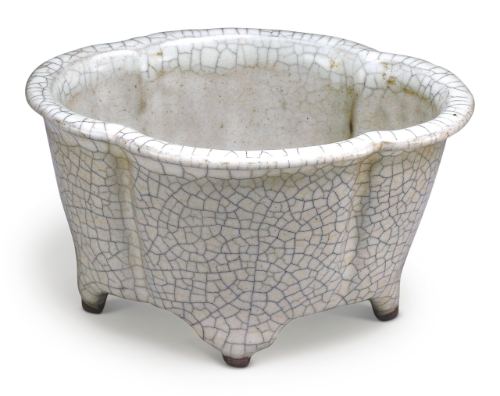
南宋至元 官窰青瓷海棠式花盆
© 台北國立故宮博物院藏品
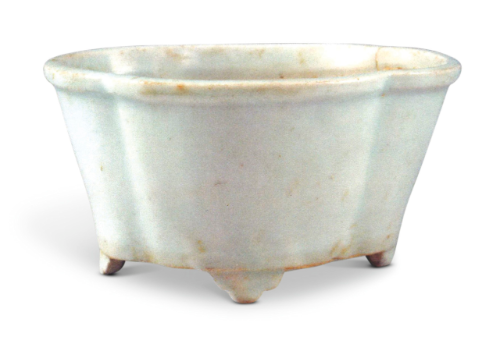
南宋 青白釉海棠式爐 江西省樟樹市劉公廟南宋開禧元年 (1205年)墓出土
圖片鳴謝:樟樹市博物館
参考:六合和熙-重要私人珍藏
104 南宋至元 官窰六方花盆
估價 10,000,000 — 15,000,000 港幣
拍品已售 12,175,000 港幣 成交價 (含買家佣金)
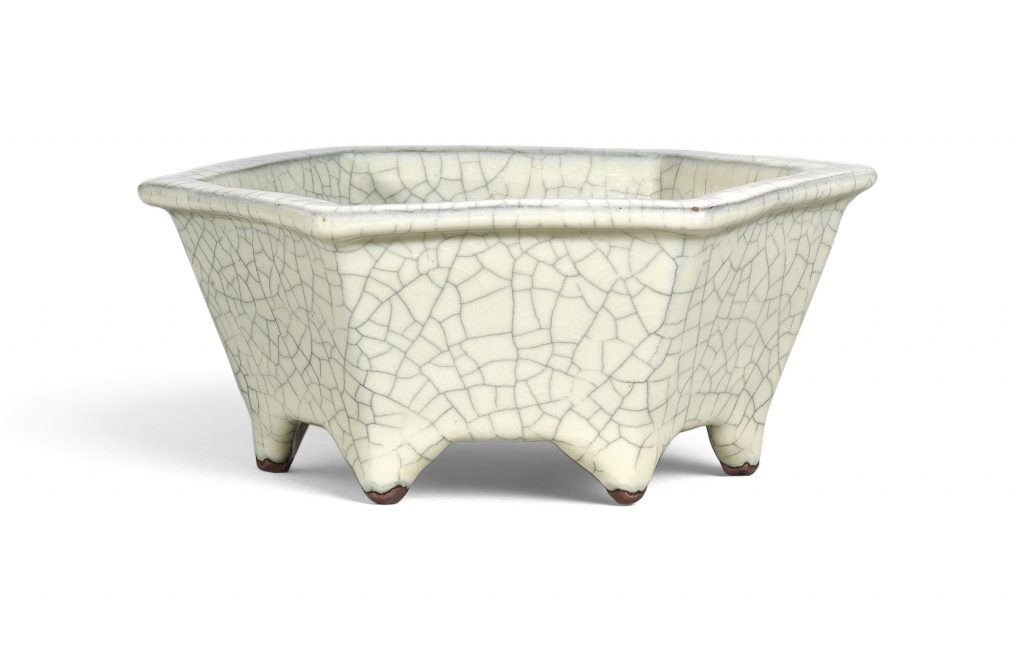
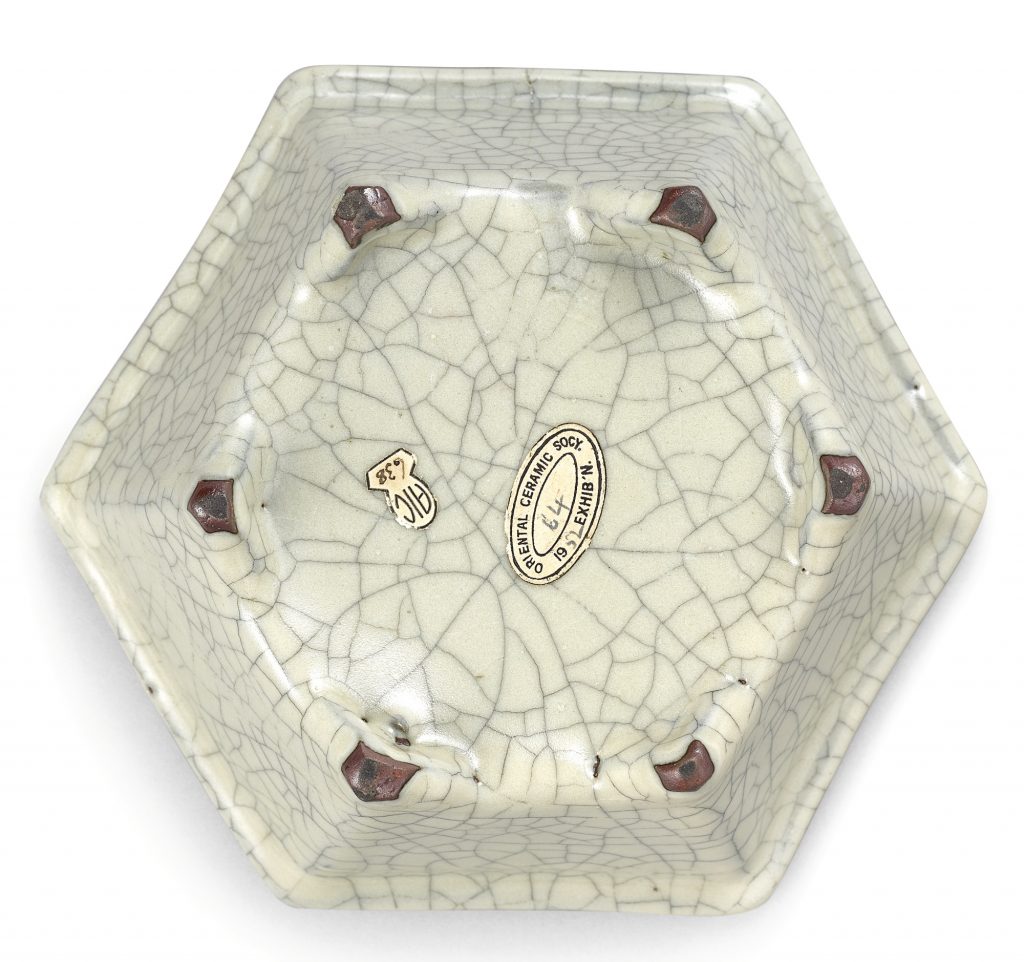
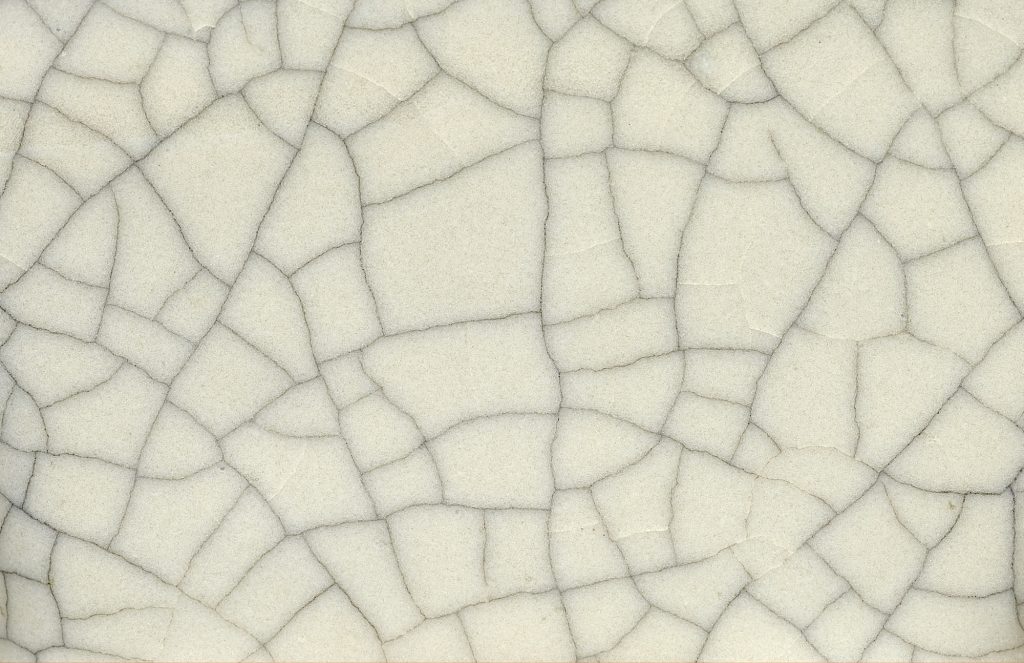
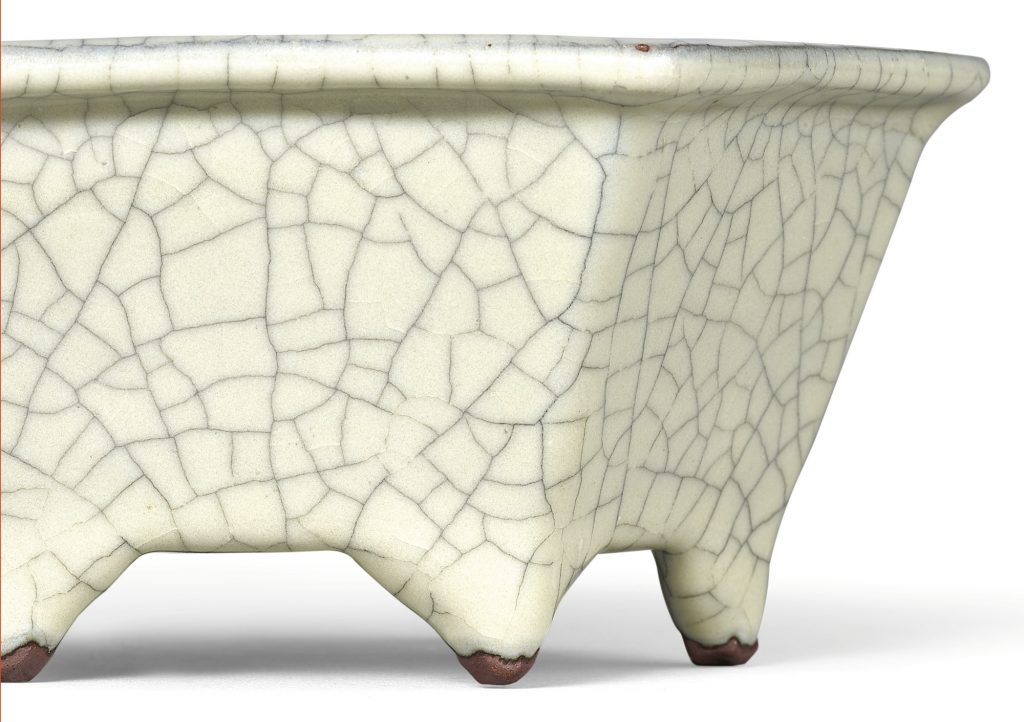
南宋至元 官窰六方花盆
16.5 公分,6 1/2 英寸
參閱狀況報告
重要拍賣通知
來源
艾弗瑞.克拉克夫人(1890-1976年)收藏,編號638
倫敦蘇富比1975年3月25日,編號112
2003年購自坂本五郎(1923-2016年)
展覽
《The Oriental Ceramic Society Exhibition of Ju and Kuan Wares: Imperial Wares of the Sung Dynasty, Related Wares and Derivatives of Later Date》,倫敦,1952年,編號64
相關資料
天人共賞
官窰六方小盆
薛好佩博士
此六方小盆所屬之類備受南宋宮廷青睞,殊為珍罕。先見其釉,稠厚緻密,呈淺灰色,亦見其胎,稍露於足,呈黑褐色。側壁平坦微斜,平添趣味,更顯六方形制之雅。此器乃南宋官瓷佳例,釉面瑩滑,片紋端勻,匠心之巧、技藝之高、氣韻之卓,盡覽無遺。
觀其特質,可知此器為修內司所造,浙江杭州市郊老虎洞窰址出。修內司設於南宋皇城內,奉詔燒製官瓷,專供宮廷。1127年,北宋瓦解,皇室自汴州(今開封)南遷,定都杭州,乃開修內司。本圖錄拍品編號105所附文章就修內司及御製官瓷另有詳述。
鑑藏中國瓷器之泰山北斗大維德爵士,寶蓄舉世無雙,現已入藏大英博物館,他對官瓷推崇有加,稱其脩美、稀貴。1952年東方陶瓷學會倫敦辦展,陳列汝、官窰,展覽引言中,大維德爵士曾言及此六方小盆與諸展品:
明末有士論汝、官、哥窰,直抒胸臆云『後此又不知凋謝如何。故餘每得一睹,心目爽朗,神魂為之飛動,頓令腹飽。豈果耽玩痼僻使然?』其後數世紀,此言一語成讖,珍稀之器或損毀或散佚,愈演愈烈。存世之量或已寥寥,時人之心或已不古,然親臨是次展覽者,悅目怡情之餘,不論愛之深淺,亦得感同身受。1
行文中,大維德爵士強調,存世官窰寥若晨星,後人盡為之傾倒。憑藉智識與慧眼,大維德爵士又對此盆深入探討,指出釉、型方面可見宋代陶匠著力仿效,官、鈞花盆之間尤多借鑒(稍後再述)。
此盆形為六方,不甚多見,同類之器多形狀有別,可比一四方官窰盆,尺寸相當,貯北京故宮博物院,刊於《官窰瓷器》,北京,2016年,圖版32(圖一)。著錄、研究故宮院藏花器之學者稱,此類小盆乃貢皇家,以盛「盆景」之用,西方則多依日文「盆栽」一詞。學者又稱,該類官窰小盆初依鈞窰形制,鈞窰小盆存量或略多。2 由此觀之,此類花盆頗受重用,尺寸小於尋常亦有其因。唐高宗(649-683年間在位)第六子章懷太子(654-684年)墓中有一繪於706年之壁畫,畫中一名僕侍,身著宮衣,手捧盆景,盆內盛有山石草木。3
早在唐代,盆景便已發展為高雅藝術,受皇室及文人垂愛。而至宋代,蘇軾(1037-1101年)、陸游(1125-1209年)等文人墨客賦詩以頌盆景之樂,將其拔至新高。陸游有詩,名曰《菖蒲》:
雁山菖蒲崑山石,陳叟持來慰幽寂。
寸根蹙密九節瘦,一拳突兀千金直。
清泉碧缶相發揮,高僧野人動顏色。
盆山蒼然日在眼,此物一來俱掃迹。
根蟠葉茂看愈好,向來恨不相從早。
所嗟我亦飽風霜,養氣無功日衰槁。4
陸游之詩,既詠盆景微縮山水,又言其器功不可沒,讚碧缶釉色青藍,慕盆中景觀蒼然。天作山水與人造盆缶彼此發揮,共得天人合一之境,備受其時雅士稱頌。不難推知,盆景所用之器,或個別燒製,或小批量產,蓋因器型需隨所盛景觀各有變化。
梁悅美撰文探討盆景藝術,指出宋代盆景所用之器多為汝瓷或鈞瓷,且不乏存例,現藏台北故宮博物院。5 比較二件鈞窰六方花盆,帶數字款,錄於《故宮藏瓷大系.鈞窰之部》,台北,1999年,圖版47、48,均刻「七」字及「養心殿明窗用」。明窗位於養心殿東,每逢新歲,皇帝於此處開筆題詞,祈祝吉祥,是為「明窗開筆典」。故知上述二例原奉養心殿明窗,其功用蘊含寓意。
此類鈞窰刻數字款花盆多為模製,底款數字由一至十,各示大小,究其意義,可參考李寶平,〈Numbered Jun Wares: Controversies and New Kiln Site Discoveries〉,《東方陶瓷學會彙刊》,卷71,2006-7年,頁65-77。其文討論此類花盆斷代之爭,觀點分為兩派,一派持北宋末年論,另一派斷代較晚,此六方小盆或與後者更符。然則,此類器之官家背景毋庸置疑。近來,有北京故宮博物院學者印證,將其歸結為「陳設類官鈞」。6 至此,已有研究確認,御用官、鈞花盆皆屬此類。
此官窰小盆出自帝苑,後於上世紀經克拉克夫人(1890-1976年)及坂本五郎(1923-2016年)二位巨擘遞藏。克拉克伉儷所藏中國瓷器在西方久負盛名,二人支持東方陶瓷學會不遺餘力,躬親參與1935至1936年間倫敦中國藝術大展籌備事宜,並借出精品數十件以作展示。1992年,大維德爵士夫人於訪談中被問及先夫最尊何人所藏,夫人答道:「當以克拉克氏所藏為最。」7 日本鑑藏大家兼骨董名商坂本五郎亦為中國藝術品之宗匠,其收藏心血及鑑賞造詣首屈一指。欲知先生生平及風骨,可參閱《Sakamoto Gorō: The Legacy》,倫敦蘇富比,2016年。
1 大維德爵士,〈序〉,《The Oriental Ceramic Society Exhibition of Ju and Kuan Wares: Imperial Wares of the Sung Dynasty, Related Wares and Derivatives of Later Date》,倫敦,1952年,頁2。
2 見《官窰瓷器》,北京,2016年,圖版32。
3 壁畫圖見梁悅美,《The Living Art of Bonsai: Principles and Techniques of Cultivation and Propagation》,紐約,2005年,頁101。普遍認為,此乃最早描繪盆景之壁畫。
4 此詩釋譯參見梁悅美,前述出處,頁102-3。
5 出處同上,頁203。
6 見《鈞窰雅集-故宮博物院珍藏及出土鈞窰磁瓷器薈萃》,故宮博物院,北京,2013年,頁168起。
7 林華田,〈An Interview with Lady David〉,《美成在久》,1992年4月,頁56-63。
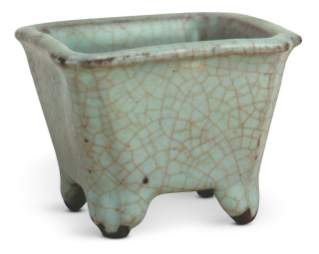
© 北京故宮博物院藏品
参考:SELECTED IMPERIAL CERAMICS FROM THE TIANMINLOU COLLECTION
1 A JUNYAO MOON-WHITE GLAZED NARCISSUS BOWL
EARLY MING DYNASTY
Estimate 2,500,000 — 3,500,000 HKD
天民樓藏御瓷選萃
2019年4月3日 | 上午 10:00 HKT
香港
明初 鈞窰月白釉鼓釘三足水仙盆 底刻「四」字
估價 2,500,000 — 3,500,000 港幣
拍品已售 5,935,000 港幣 成交價 (含買家佣金)




明初 鈞窰月白釉鼓釘三足水仙盆 底刻「四」字
22 公分,8 5/8 英寸
簡介
自五十年代始,葛士翹集寶存菁,搜藏中國珍瓷,建立天民樓珍藏,所蓄青花御瓷,更可謂私人收藏之冠,無出其右。專場精選天民樓藏明清瓷器十八件,所呈重器包括永樂青花纏枝番蓮折沿盆,形仿中東金屬器,加綴鈷藍寶相花,異風巧蘊,又獻宣德青花番蓮紋大盌,鈷青濃淡得宜,典雅大方。佳器還有宣德青花穿花龍紋盤,悅目賞心,以及明永宣青花龍紋小罐,妙畫翼龍乘浪而翔,天威盡展,臻絕罕見。
來源
倫敦蘇富比1974年12月3日,編號412
展覽
《日昇月騰:從敏求精舍藏品看明代》,香港歷史博物館,香港,2015-2016年,編號101
相關資料
葛士翹與天民樓藏瓷
康蕊君
「葛氏藏品是當今最優秀的私人陶瓷收藏之一,其內容令人讚歎不已。」
約翰.艾爾斯(John Ayers)在1987年展覽圖錄序文是這樣形容葛士翹(1911-1992年)的天民樓收藏。縱使三十載已過,葛士翹藏瓷,依舊卓犖超群。以物證史,羅列埏埴雅器,記錄十四至十八世紀景德鎮的登峰造極,自蒙元(1279-1368年)肇始,經朱明(1368-1644年)鼎盛,達滿清(1644-1911年)大興,普天之下,無可匹敵。
現借專場所呈,一窺葛氏所藏。天民樓寶蓄之器,經嚴選慎挑,展示數百年來瓷藝技術與風格的嬗變,尤為難得。其中又以青花為優,既有元代重器,兼集明初逸品,包括成化(1465-1487年)稀世宮盌、晚明大膽鉅作、清初擬明雅物,是以凡言及天民樓名號,蓋念其青花瓷藏。然其彩瓷及單色釉絕不失色,特別是晚明五彩,以及康熙(1662-1722年)、雍正(1723-1735年)與乾隆(1736-1795年)三朝珍瓷如康熙琺瑯彩盌,包羅萬象,精妙絕倫。
葛士翹眼光獨到,明鑑善藏,且對所蓄之物,淵學通解,致使天民樓譽望所歸。葛氏曾擔任著名收藏家協會敏求精舍主席,輔助香港相關博物館不遺餘力,特別是香港藝術館、香港中文大學文物館及香港大學馮平山博物館,慷慨借展,德藝雙馨。1987年假香港藝術館展出珍存,並出版精美圖錄《天民樓藏瓷》一套兩冊,以中英雙語闡述所藏雅瓷。除約翰.艾爾斯、朱湯生與譚志成,葛士翹也撰寫專文〈明清彩繪瓷器的發展〉,說明該組瓷器的歷史嬗變,態度中肯,不驕不躁,未有自誇其成,雖身為藏家,卻秉虛懷、持謙遜,難能可貴。
《天民樓藏瓷》圖錄,刊印彩照細緻悅目,絕大部分藏品更附有全景圖,配合學術研究,深入探討,讓該作成為鑽研景德鎮瓷器的必要讀物。葛士翹想必以教育為先,並冀將收藏公諸同好,是以解囊資助,使圖錄初發行時以廉價出售,惠澤廣眾。他又大方分享雅蓄,讓學者、學生與其他藏家親身鑑賞,眼觀、手觸、修習、研討。
「天民樓」之名,與中國文學傳統一脈相承,引經據典,出自詩人陶淵明(365-427年)的《五柳先生傳》。據文,「五柳先生」安貧守道、好學隨心、淡薄名利,貫徹道家思想。陶氏在此短文中,以五柳先生自況,並在末句寫:「葛天氏之民歟?」,指先生猶如傳說上古王帝葛天氏的子民,過著淳樸樂道的生活。「天民樓」之名,配合典故,意即「葛天氏子民之樓」,暗藏「葛」姓,饒富文人詩韻。
_________________________________
此類水仙盆,亦稱「鼓釘」洗,其胎骨厚實,器形穩健,釉質肥潤如凝脂,呈色月白,器沿釉薄而漸趨透明,色澤變幻至臻至美,是為鈞瓷顯徵。本品釉色微藍朦朧,彷若蒼穹,內見蟠屈粗紋,謂之「蚯蚓走泥紋」。鈞釉水仙盆自燒造伊始,便備受推崇,所出器形比例、釉色不一,見於世界頂級公私收藏。
此類鈞瓷品質卓然,其燒造年代素具爭議,眾說紛紜,以北宋、元末及明初論為主流。近鈞窰遺址處地表發掘一「宣和元寶」錢範殘器,由鈞瓷土製,可視之為北宋一說之實證,備受專家認同。然於禹州(2005年)及深圳(2006年)學術會議,錢範之年代卻遭質疑:其一,錢範與本朝元寶實物不符;其二,錢範背面還銘有前朝之偽款。此非議一出,北宋之說似不足為信。上海博物館就鈞瓷碎片進行測試,指其年代當為元末或明初。此外,可見一最新發掘之鈞壺例,器形與明梁莊王墓(1441年)出土之金壺甚為相似,此亦可視為明鈞之佐證。
大量鈞窰水仙盆後刻殿名,以分辨其所貯之地,多屬兩岸故宮清宮舊藏。然清宮舊藏乏元代遺存,難以為元朝一說作證。以此觀之,明初一說更為貼切,相若鈞窰花盆或受命於上,為永樂帝為其新都皇宮專門定燒。再者,此類器皿未見於明以前之繪畫或文字記載,而明初景德鎮所製青釉瓷盆與之器形相仿,可作旁證,見宣德地層出土例,展於《景德鎮出土明宣德官窰瓷器》,鴻禧美術館,台北,1998年,編號39。
可比較一相近之水仙盆例,現藏北京故宮博物院,圖見《鈞窰雅集:故宮博物院珍藏及出土鈞窰瓷器薈萃》,北京,2013年,圖版94至96、113、115及116,此書同錄鈞窰遺址發掘之殘器例,圖版97、98,以及一修復例,禹州市出土,圖版114及頁343之圖12-1、12-2。另比較鈞窰玫瑰紫釉花盆二例,屬台北故宮博物院雅蓄,圖載於《故宮藏瓷大系:鈞窰之部》,台北,1999年,圖版32及33。
此類花盆底部多以數字為記,從一至十,或示尺寸。見一「四」字款例,W. Kilgenberg 博士及 Reach 家族舊藏,展於《Chinese Art from the Reach Family Collection》,埃斯卡納齊,倫敦,1989年,編號24,售於香港佳士得1997年4月28日,編號696,後兩度售於蘇富比,分別為香港2000年5月2日,編號590,及倫敦2015年11月11日,編號81。再參考趙從衍典藏天藍釉例,售於香港蘇富比1987年5月19日,編號210。
A JUNYAO MOON-WHITE GLAZED NARCISSUS BOWL
EARLY MING DYNASTY
with shallow rounded sides curving down to a flat base supported on three gently flaring ruyi-shaped feet, the rim bordered with a band enclosing evenly spaced rounded studs between two narrow raised ribs, above a further band of studs above the feet, the well-proportioned body richly applied with an attractive milky-blue glaze thinning to a mushroom tone along the raised edges and extremities, the interior with characteristic ‘earthworm tracks’, the base incised with a character si (four), surrounded by a ring of spur marks revealing the pale buff stoneware body
22 cm, 8 5/8 in.
PROVENANCE
Sotheby’s London, 3rd December 1974, lot 412.
EXHIBITED
The Radiant Ming 1368-1644 through the Min Chiu Society Collection, Hong Kong Museum of History, Hong Kong, 2015-2016, cat. no. 101.
CATALOGUE NOTE
Ko Shih Chao and the Tianminlou Collection
Regina Krahl
It was with a distinct shock of pleasure that I realized the extent of his success in assembling what is unquestionably one of the finest groups of these wares to be seen anywhere in private hands today…
This is how in 1987 John Ayers characterised the collecting activity of Ko Shih Chao (1911-1992) and his Tianminlou Collection, when he wrote an introduction to the collection catalogue. Thirty years later, the collection once assembled by S.C. Ko can still be considered one of the most remarkable private assemblages of porcelains made at Jingdezhen during the Yuan (1279-1368), Ming (1368-1644) and Qing (1644-1911) dynasties, the period from the fourteenth to the eighteenth century that marked the kilns’ unchallenged position as the world’s foremost porcelain producers.
The Tianminlou Collection – part of which is offered in this sale – offers a very rare, astutely chosen overview of the technical and stylistic developments of the kilns’ production during this time. That the collection name may first of all evoke blue-and-white porcelain is not surprising, given that this section is particularly strong and representative, containing powerful Yuan pieces, exquisite examples of the early Ming period, one of the extremely rare Chenghua (1465-1487) ‘palace bowls’, bold vessels of the late Ming and the refined echoes of early Ming wares made in the first half of the Qing dynasty; yet the collection is equally remarkable in polychrome and monochrome porcelains, especially the wucai wares of the late Ming and a great variety of superb examples produced during the Kangxi (1662-1722) Yongzheng (1723-1735) and Qianlong (1736-1795) reigns, including one of the most highly prized types, a Kangxi falangcai bowl.
S.C. Ko was not only a discerning collector, but above all had himself an excellent understanding of the subject, without which the collection could not have achieved this high standard. He was chairman of the honourable Min Chiu Society of collectors and actively involved in the affairs of all the relevant Hong Kong museums, the Hong Kong Museum of Art, the Art Gallery of the Chinese University of Hong Kong and the Fung Ping Shan Museum of Hong Kong University, and was of course a generous lender to exhibitions. On the occasion of the special exhibition of his own collection at the Hong Kong Museum of Art in 1987, a superbly produced bi-lingual two-volume publication was produced, Chinese Porcelain. The S.C. Ko Tianminlou Collection, which represents the collection catalogue. Besides John Ayers, Julian Thompson and Laurence C.S. Tam, S.C. Ko contributed an essay himself on ‘Polychrome Porcelain of the Ming and Qing Dynasties’, where he detailed the historical development of this group of wares in a neutral, unbiased manner rarely seen in a collector, without attempting to present his own pieces in a particularly favourable light.
With its rich illustrations, that included panoramic views for a majority of vessels, and the thorough research that went into it, the catalogue remains a standard reference work of Jingdezhen porcelain; and since S.C. Ko generously subsidised it, it could at the time be offered at an unusually low price, which assured its wide distribution. The educational aspect and the wish to share his collection with a large audience were clearly matters of importance to him. Thus he also made his pieces readily available to the scholarly community, to students as well as fellow collectors, to be physically handled, studied and discussed.
In line with the Chinese literati tradition, the hall name, Tianminlou, that was chosen for the collection, is deeply anchored in China’s classical literature. It can be traced to a short autobiographical piece by Tao Yuanming (365-427), one of China’s most revered poets, where he describes a ‘Mr Five Willow Trees’ as living the Daoist ideal of a poor but free life, keen to increase his knowledge, but uninterested in personal recognition, fame, or even just approval of society. In the last line of his story Tao asks ‘Is he perhaps one of Emperor Getian’s people?’ (‘Getian … min …’), Emperor Getian being a mythical ruler of a prehistoric past marked by simplicity and happiness. Ge is the modern transcription of the family name Ko and Tianminlou only makes sense in combination with this family name, lou denominates a lofty pavilion. ‘[S.C.] Ko Tianminlou’ (Getian min lou) may thus perhaps be understood as ‘The Pavilion of One of Getian’s People’.
_____________________________________
This form of this narcissus bowl, also known as ‘drum nail’ basins, belongs to a distinct group of flower receptacles known as ‘numbered Jun’ wares, mostly made in moulds and generally inscribed on the base with numerals from one to ten that seem to correspond to the size of the vessels. This type radiates the essence of Jun ware which derived its beauty from their robust forms which were coated in a contrasting luminous thick glaze of varied moon-white colouration that becomes almost transparent around the edges of the vessel where the glaze thins significantly. On the present bowl the glossy glaze is reminiscent of a hazy blue sky, infused with the characteristic markings that have become known as ‘earthworm tracks’. Highly prized throughout Chinese dynastic history since their production, these striking vessels were produced in a variety of proportions and glaze colours and are found in some of the most important museums and private collections of Chinese art.
The dating of these wares has been long debated and continues to divide opinions between a Northern Song (960-1127), late Yuan (1279-1368) and early Ming (1368-1644) attribution. The Northern Song date, adhered to by many eminent Chinese scholars, was supported by a surface find near the kiln sites of a mould fragment for coins bearing the Xuanhe reign name (1119-1125), made of Jun ware clay. However, at scholarly conferences on the subject in Yuzhou in 2005 and in Shenzhen in 2006, the date of the coin mould itself came under scrutiny and was basically discredited, since it was shown not to be a mould for actual coins of that period and to bear a spurious reign mark of an even earlier period on the reverse. Scientific tests of sherds undertaken by the Shanghai Museum have pointed to a late Yuan or early Ming date. A newly discovered Jun ewer very similar in shape to a gold ewer from the tomb of King Zhuang of Liang, buried in 1441, has also been offered as evidence for a later dating.
Since a large body of such Junyao wares remains in the Chinese imperial collection both in the National Palace Museum, Taipei, and the Palace Museum, Beijing, often inscribed after firing with the names of Palace halls, a Yuan date seems less likely, as virtually no Yuan ceramics formed part of the Qing court collection. The production of these flower vessels fits better into the early Ming dynasty, and they may well have been officially commissioned for the newly built imperial palace in Beijing in the Yongle period (1403-1424). Furthermore, these vessels do not appear in any pre-Ming text or painting, and their form is similar to early Ming celadon-glazed flower vessels, such as one included in the exhibition Xuande Imperial Porcelain Excavated at Jingdezhen, Chang Foundation, Taipei, 1998, cat. no. 39.
See similar bowls of this type, in the Palace Museum, Beijing, illustrated in Selection of Jun Ware. The Palace Museum’s Collection and Archaeological Excavation, Beijing, 2013, pls 94-96, 113, 115 and 116, together with fragments excavated from the kiln site, pls 97-98 and one excavated in Yuzhou city (pl. 114 and p. 343, figs 12-1 and 12-2). The inscription on the base is also consistent with examples from the Qing court collection and now preserved in the National Palace Museum, Taipei, published in A Panorama of Ceramics in the Collection of the National Palace Museum: Chun Ware, Taipei, 1999, pls 32 and 34.
See another narcissus bowl inscribed with the numeral si (four) from the Dr W. Kilgenberg and Reach Family collections, included in the exhibition Chinese Art from the Reach Family Collection, Eskenazi Ltd, London, 1989, cat. no. 24, sold at Christie’s Hong Kong, 28th April 1997, lot 696, again in these rooms, 2nd May 2000, lot 590, and a third time in our London rooms, 11th November 2015, lot 81. See also a blue-glazed bowl from the collection of T.Y. Chao, sold in these rooms, 19th May 1987, lot 210.

![[临渊阁]天地一家春](https://www.antiquekeeper.ca/wp-content/uploads/2023/03/antiquekeeper_banner_image_2-4.jpg)
